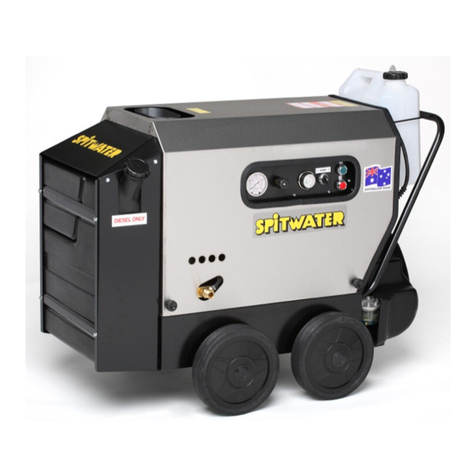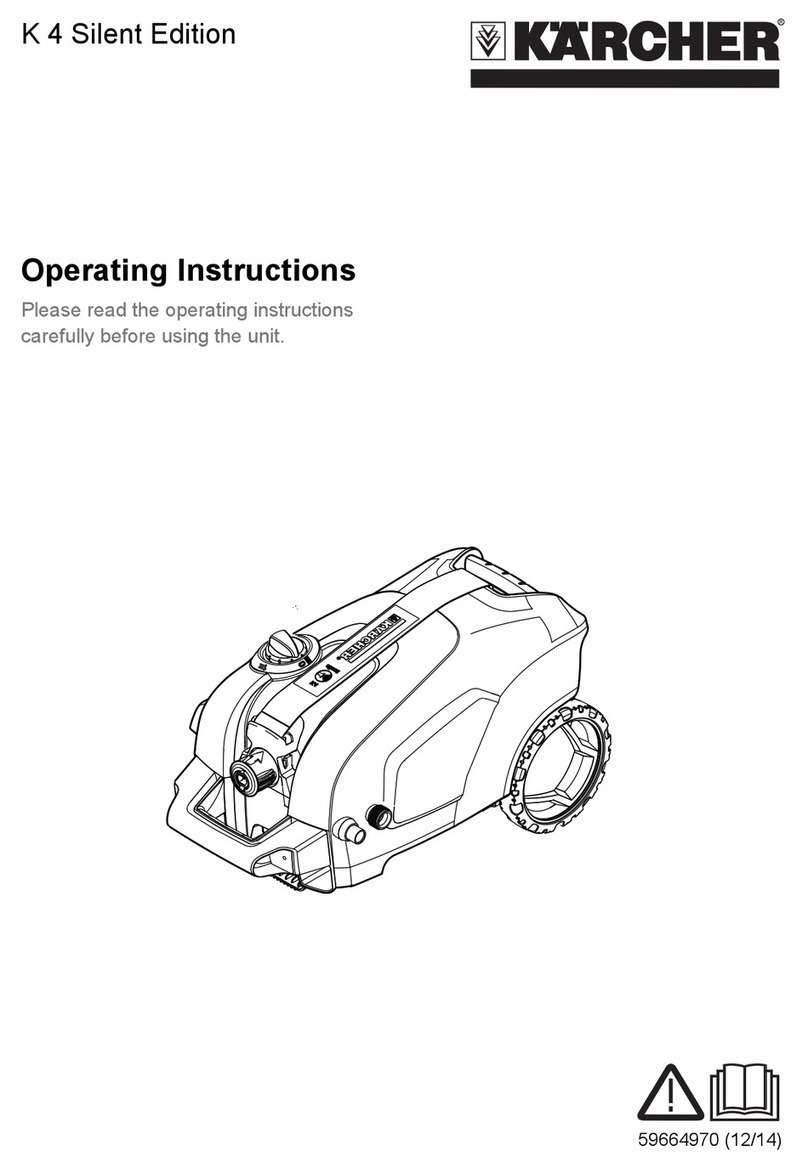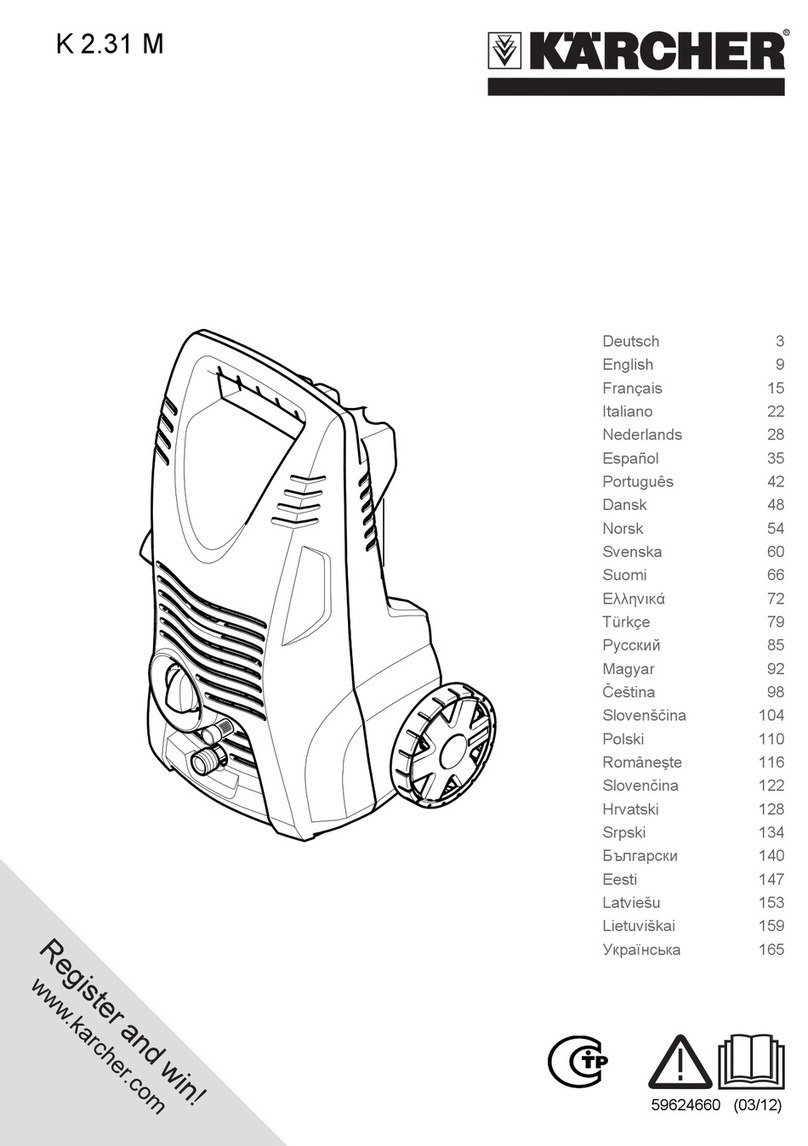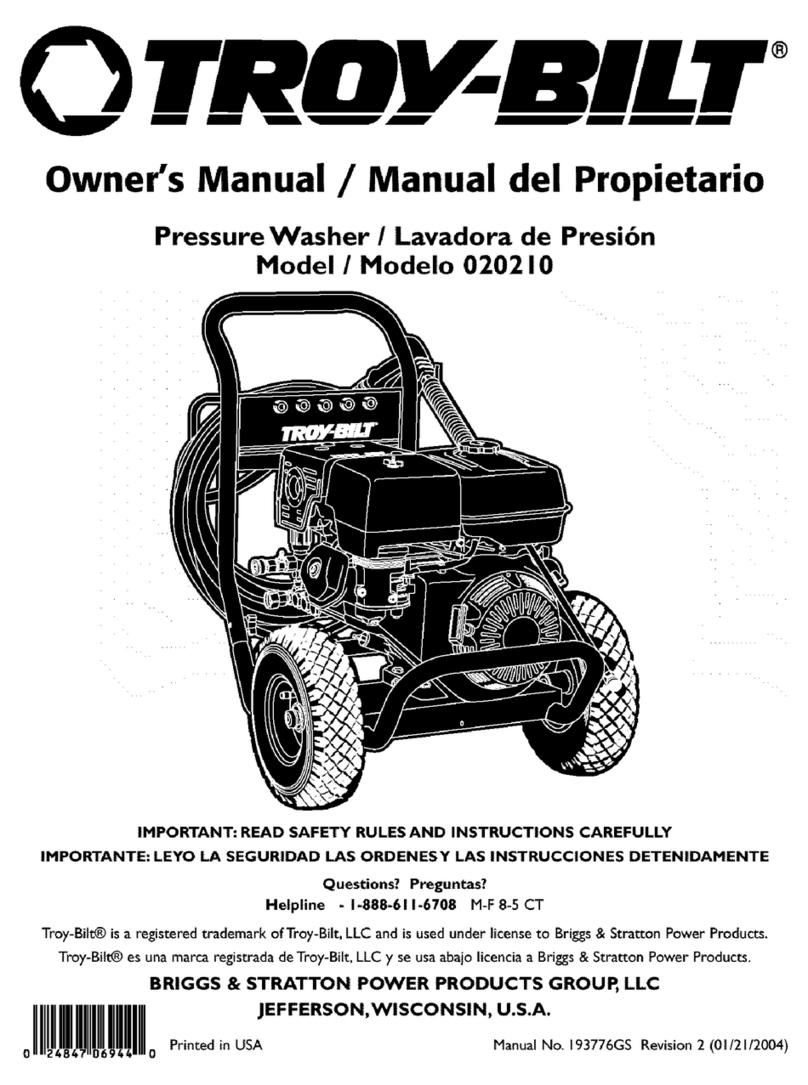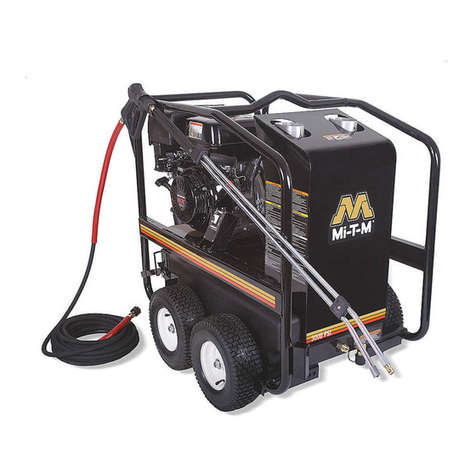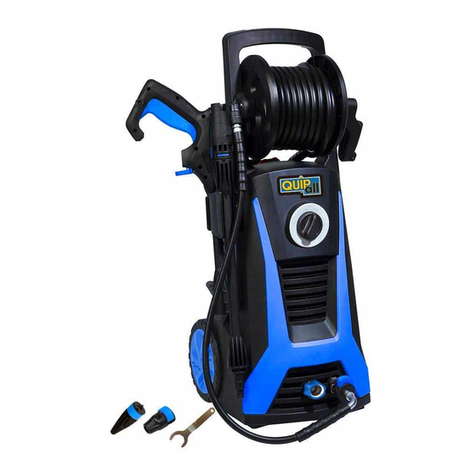Pressure-Pro SH40004HH User manual

DOC0087 REV A
Pressure-Pro Gas Powered, Diesel
Heated, Direct Drive Portable
Instructions for Use


3
Contents
1
Important safety instructions....................................................................................................4
2
Description.................................................................................................................................5
2.1 Purpose............................................................................................................................... 5
3
Before starting the machine......................................................................................................6
3.1 Fuel andairmixture..............................................................................................................6
3.2 Fill up fuel tank ....................................................................................................................6
3.3 Connecting the high pressure hose...................................................................................... 6
3.4 Connecting the water supply................................................................................................6
4
Control / Operation ....................................................................................................................7
4.1 Connections.........................................................................................................................7
4.2 Switching on the cleaner......................................................................................................7
4.3 Using cleaning agents..........................................................................................................7
5
Applications and methods ........................................................................................................8
5.1 Techniques.....................................................................................................................................8
5.2 Some typical cleaning tasks............................................................................................ 9-10
6
After using the cleaner ............................................................................................................11
6.1 Switching off the cleaner.................................................................................................... 11
6.2 Storing / frost protection..................................................................................................... 11
7
Maintenance.............................................................................................................................12
7.1 Maintenance Schedule............................................................................................................................12
7.2 Maintenance work....................................................................................................................................12
8
Troubleshooting ......................................................................................................................13
8.1 Other faults................................................................................................................................................13
8.2 Technical Specification......................................................................................................13
9
Further informatio..n..........................................................................................................................................................13
9.1 Recycling the machine........................................................................................................ 13
9.2 Warranty.........................................................................................................................14-15

4
Symbols used to mark in-
structions
Before using the
high-pressure
cleaner, be sure
to also read the
enclosed operating
instructions and
keep them within reach at all
times.
Safety instructions
in these operat-
ing instructions
which must be
observed to
prevent risks to persons are
marked with this danger symbol.
This symbol is used
to mark safety in-
structions that must
be observed to pre-
vent damage to the
machine and its perfor-
This indicates
tips and in-
structions to sim-
plify work and to
ensure safe operation.
Operations marked
with this symbol
should only be
carried out by
Qualified Service
Technicians.
mance.
1
Important safety instructions
High Pressure Washer -
SAFETY INSTRUCTIONS

5
2
Description
2.1
Purpose Thishigh-pressure cleanerhas
been designed for professional
use in
-Agriculture Industry
-Transport Industry
-Automotive
-Municipal Facilities
-Janitorial
-Construction
-Food Industry, etc.
Section 5 describes the use of the
high-pressure cleaner for various
cleaning jobs.
Always use the cleaner as
described in these operating
instructions. Any other use may
damage the cleaner or the
surface to be cleaned or may
result in severe injury to persons.
WARNING! Do not use combustion engine powered machines indoors unless adequate ventilation is
assessed by national labor authorities.
WARNING! Ensure that any exhaust emissions are not in a vicinity ofair intakes.
WARNING! Incorrect fuels shall not be used as they may provehazardous.

6
3
Before starting the machine
3.1
Fuel and air mixture
Every fuel-burning appliance, such as pressure washers, depends upon a proper mix of fuel
and air (by weight) for proper combustion.Thereforesomeadjustment of the air supply to the
burner may be necessary to take account and the resulting air pressure.This is true whether
your fuel is ‘Natural gas’, Propane or Diesel.
Your hot water pressure washer was thoroughly tested and adjusted for optimum performance
before it left our factory.
If your location is higher than 1200m (3900 ft) above sea level, your burner may require
re-adjustment for proper performance and best fuel economy. Contact your local Dealer
for assistance.
3.2
Fill up fuel tanks
With the machine cold and turned off:
1. Fill burner tank from a clean container with fresh diesel fuel
2. Fill engine tank from a clean container with fresh gas.
Use clean fuel only, free of moisture and contamination.
Contact your dealer for fuel source and type
recommendations.
Maximum storage time in high pressure
cleaner diesel tank: 1 month.
Fuel stored externally for more than 6
months is not allowed to be filled into high
pressure cleaners.
NOTE!
At temperatures below 46°F the fuel oil begins to solidify (paraffin precipitation). This
can lead to difficulties in starting the burner. Before the winter months it is
recommended that a fuel conditioner/stabilizer be added (available from the fuel oil
trade). Filling up the engine with fuel, see the enclosed instructions for the engine.
3.3
Connecting the pressure hose
1. Connect the high pressure hose quick connector to the high pressure nipple.
3.4
Connecting the water
1. Attach hose coupling to the
water supply hose.
2. Rinse the water supply hose
briefly in order to prevent
sand and other dirt particles
entering into the machine.
3. Attach hose coupling to inlet.
4. Open water supply faucet.
NOTE!
In the case of poor water quality
(sand, etc.), it is recommended that
an inlet water filter be installed.
Water supply hose should be a
reinforced hose and have a
minimum inside diameter of
3/4" (19 mm).

7
4
Control / Operation
4.1
Connections
4.1.1 Connecting the spray nozzle to wand
Insert spray nozzle into wand quick connect.
NOTE!
Always remove any dirtfrom
the nipple before connecting
the nozzle to the spray gun.
4.2
Switching on the cleaner
4.2.1
Cold water operation
Before starting up the engine, you must
carefully read through the instructions for use
of the engine. In the instructions for use the
operation and service of the engine is
described.
When the engine has been started, the high
pressure washer can be used for cleaning
with cold water.
4.2.2
Hot water operation
1. Turn the burner switch to the
on position.
2. Set thermostat to desired
temperature.
3. Unlock the spray handle and
squeeze the trigger.
4. The oil burner will start.
5. Release the trigger and lock
the spray handle when not in
use.
4.3
Using cleaning agents
If you want to use detergents, you
will need an external injector.
Please contact your local
distributor for further information.
CAUTION!
Never allow cleaning agent
to dry on the surface to be
cleaned. The surface may be
damaged.

8
5Applications and methods
5.1
Techniques
5.1.1 Soaking
5.1.2 Detergent and Foam
5.1.3 Temperature
5.1.4 Mechanical Effect
5.1.5 High Water Flow or
High Pressure
Efficient high pressure cleaning is achieved by following a few
guidelines, combined with your own personal experience of specific
cleaning tasks. Accessories and detergents, when correctly chosen,
can increase the efficiency of your pressure washer. Here is some
basic information about cleaning.
Encrusted or thick layers of dirt can be loosened or softened up by a
period of soaking. This is for example an ideal method within
agriculture –for example, within pig sties. The ideal soaking method
can be achieved by using foam or simple alkaline detergent. Let the
product lie on the dirty surfaces for about 30 minutes before
pressure washing. The result will be a much quicker high pressure
cleaning process.
Foam or detergent should be applied onto dry surfaces so that the
chemical product is in direct contact with the dirt. Detergents are
applied from bottom to top, for example on a automobile bodywork,
in order to avoid “super clean”areas, where the detergent may
collect in higher concentrations and streams downwards. Let the
detergent work for several minutes before rinsing and never let it dry
on the surface being cleaned.
Detergents are more effective at higher temperatures. Greases, oils
and fats can be broken down more effectively at higher
temperatures also. Proteins can be cleaned at temperatures of
around 60°C (140°F). Oils and traffic film around 70°C (158°F), and
grease can be cleaned at 80°-90°C (176-194°F).
In order to break down tough layers of dirt, additional mechanical
effect may be required. Special lances and rotary or wash brushes
offer this supplementary effect that cuts through dirt.
High pressure is not always the best solution and may also damage
surfaces. The cleaning effect also depends upon water flow.
Pressure levels of around 100 bar (1450 psi) may be sufficient for
vehicle cleaning (in association with hot water) and higher flow
levels give the ability to rinse and flush away large amounts of dirt
easily.

9
5.2
Some typical cleaning tasks
5.2.1 Agriculture
Task Accessories Method
Stables
Pig Pens, Sties Chemical Foam
Injectors 1. Soaking –apply foam to all surfaces (bottom to top)
and wait for approx. 30minutes.
2. Remove the dirt from surfaces with the high
pressure lance or chosen accessory. Again,clean
from bottom to top on vertical surfaces.
3. Toflush away large quantities of dirt, change to low
pressure mode and use the higher flow to push
away the dirt.
4. Use recommended disinfectant products and
methods to ensure hygiene. Apply disinfectant
once the surfaces are perfectly clean.
Cleaning of
walls, floors and
equipment
Foam Lance
Floor Cleaner
Disinfectant
Detergents
Disinfectant
Machinery Detergent injection 1. Apply detergent to vehicle or equipment surfaces in
order to soften up dirt and grime. Apply from bottom
to top.
2. Proceed with cleaning using the high pressure
lance. Clean again from bottom to top. Use
accessories to clean in diffi cult to reach places.
3. Clean fragile areas such as motors, rubber at lower
pressure levels to avoid damage.
Tractors
lances and
Ploughs etc.
underchassis washers
brushes
5.2.2 Vehicle
Task Accessories Method
Vehicle bodywork Standard lance
Detergent injection
under chassis
washers brushes
Detergents
1. Apply detergent to vehicle or equipment surfaces in
order to soften up dirt and grime. Apply from bottom
to
top. In cases of particularly dirty vehicles, pre-spray
with a recommended dealer product in order to
remove traces of insects etc, then rinse at low
pressure and apply normal car cleaning detergent.
Let detergents settle for 5 minutes before cleaning off.
Metallic surfaces can be cleaned using a
recommended dealer product.
2. Proceed with cleaning using the high pressure lance.
Clean again from bottom to top. Use accessories to
clean in difficult to reach places. Use brushes in order
to add a mechanical cleaning effect. Short lances can
help for cleaning of motors and wheel arches.
Undercarriage washers can be valuable for the
cleaning of car underchassis and wheel arches.
3. Clean fragile areas such as motors, rubber at lower
pressure levels to avoid damage.
4.
Apply a liquid wax using the pressure washer in order
to protect the bodywork from pollution.

10
5.2.3 Buildings and Equipment
Task Accessories Method
General surfaces
Metallic equipment
Foam injectors
Standard lance
Tank cleaning
head
Disinfectant
1. Apply thick foam over the surfaces to be cleaned.
Apply on dry surfaces. Apply from top to bottomon
vertical surfaces. Let the foam act for up to 30
minutes for the optimal effect.
2. Proceed with cleaning using the high pressure
lance. Use applicable accessories. Use high
pressure to dislodge large amounts of encrusted dirt
or grime. Use lower pressure and high water volume
in order to rapidly flush away loose dirt and rinse
surfaces.
3. Apply disinfectant once the surfaces are perfectly
clean.
Areas covered by amounts of loose dirt, such as animal
remains in slaughterhouses, can be removed by using
high water fl ow to flush away the dirt to evacuation pits
or drains.
Tank cleaning heads can be used to clean barrels, vats,
mixing tanks etc. Cleaning heads may be hydraulically
or electrically powered and give the possibility for
automatic cleaning without a constant user.
These are merely several examples of cleaning tasks that can be solved by a pressure washer in association with
accessoriesanddetergents.Eachcleaningtaskisdifferent.Pleaseconsultyourlocaldealerorqualifiedrepresentative
in order to discuss the best solution for your own cleaning tasks.

11
6After using the cleaner
6.1
Switching off the cleaner
1. Turn the burner switch to "OFF"
position.
2. Activate spray handle for 1 minute
minimum on cold water to cool
down system.
3. Turn "OFF" engine.
4. Close water tap.
5. Activate spray handle until the
washer is depressurised.
6. Lock the safety catch on the spray
handle.
6.2
Storing / frost protection
It is advisable to store the machine in a
frost proof place between operations. If
this is not possible the machine should
be protected in the following way:
1. Disconnect the water inlet hose.
Remove the nozzle andempty it of
water.
2. Start the machine allowing it to run
with the spray handle opened until it
is empty of water.
3. Place a suction hose in a bucket
with 6-8 liters (1.5-2 gallons)
anti-freeze.
4. Place the spray handle (without
spray nozzle) above the bucket,
activate the spray handle so that the
anti-freeze can circulate.
5. Place the spray handle above the
opening of the anti-freeze container
and allow the machine to pump all of
the solution back into the anti-freeze
container. The anti-freeze can be re-
used, but keep in mind that it is slightly
diluted with water each time this is
done.
Important:
To avoid damage always ensure that
the washer, the hoses and the spray
lance are unfrozen before restarting.
Place the washer and the accessories
in a warm environment for some time
before starting up.

12
7Maintenance
7.1
Maintenance Schedule
Weekly
After the first 50
operating hours
Every six
months or
500 operating
hours
As
required
7.2.1 Water filters n
7.2.2 Oil filter n
7.2.3 Checking the pump oil quality n
7.2.4 Changing the pump oil n n
7.2.5 Emptying the fuel oil tank n
Service on engine: See attached user instructions for engine.
7.2
Maintenance Work
7.2.1 Water filters
1. Unscrew quick coupling.
2. Remove filter with tool and clean it.
7.2.2 Checking the pump oil quality
1. Check color of pump oil.
If the oil has a gray or white shade, change the oil (see
section 7.2.3)
2. Topoff oil level with fresh oil if necessary.
Oil type
7.2.3 Change of oil
1. Unscrew the oil drain plug and drain oil into a suitable container.
2. Check that the drain plug gasket is in place and reinstall drain plug.
3. Fill pump with proper grade and amount of oil.
Oil grade and capacity
7.2.5 Cleaning of fuel filter
On the back of the fuel tank where the hoses are mounted, there is a filter.
To clean this or these filters (depending on model), dismount the hose and unplug the hose nipple.

13
8 Troubleshooting
8.1
Other Faults
Fault Cause Remedy
>
>
Engine not started
Engine RPM too low
•
Start engine.
Adjust RPM on thespeed
control to max.
Cold water operation possible.
Pressure too low
>
High pressure nozzle worn
out
•
Replace nozzle
Burner soots
>
Fuel contamination Contact Service
>
Burner sooted or adjust-
ment incorrect
8.2
Technical Specifications
9Further information
9.1
Recycling the machine
Make the old cleaner
unusableimmediately.
The pressure washer contains valuable
materials that should be recycled.
Contact your local waste disposal site. If
you have any quetions, please contact
your local authorities or your nearest
dealer.

THANK YOU: The employees and management thank you
for selecting the Pressure-Pro brand product line. The
production and quality assurance team have taken the
greatest care to ensure that your new pressure washer
exceeds the standards set by you, the customer.
YOUR RESPONSIBILITY: An operator’s manual was
compiled for your benefit. By studying and following the
safety, installation, operation, maintenance, and
troubleshooting information contained within, you can look
forward to many years of trouble-free service from your
equipment. Every person who will operate the equipment
must read and follow the safety warning and operating
instruction sections of the owner’s manual prior to use. You
areresponsibleforoperatingtheproductproperlyandsafely.
Youarealsoresponsible tofollowthemaintenanceschedule
on the back page of the manualto keep your warrantyactive.
FREIGHT DAMAGE: If delivered by a trucking company,
please inspect for any concealed freight damage and note
this on the paperwork from the trucking company before
signing. Should you find damage has occurred during
shipping, do not return the damaged merchandise to
manufacturer, but file a claim immediately with the freight
carrier involved.
QUESTIONS: Help us provide you with the fastest service.
Please locate the warranty registration card enclosed and
return it to manufacturer to register your machine.
If problems occur, contact the dealer you bought your
machine from, a local authorized Pressure-Pro service
center, or call manufacturer at 1-(772) 461-4486 and ask for
technical services.
GETTING STARTED: If your dealer has not prepared the
machine for startup, you may need to connect the hose to the
pressure outlet onthewasher and connect the other end of the
hose that swivels to the trigger gun inlet and tighten. Engine
powered pressure washers are shipped from themanufacturer
with the fuel tanks empty. Follow the operation instructions for
starting. Electric motor powered pressure washers will require
an appropriate electric outlet or disconnect box and an electric
plug that is rated for your machine’svoltage and amperage and
matches to your electrical socket. Smaller machines are
equipped with a ground fault interrupter on the electrical cord
and you will need to press the reset button after it is plugged in.
ONE YEAR PARTS : Manufacturer promises to repair
Pressure-Pro branded pressure washers if defective in
materials or workmanship for one year from the date of
original retail purchase including the cost of PARTS
excluding transportation/shipping costs and travel time.
ONE YEAR PARTS WARRANTY: Manufacturer will provide
replacement parts on accessories and on all other product
brands including Hydro Twisters, Hydro Vacuum systems
and Hydro Loop.(Labor is not included)
TWO YEAR EVAPORATIVE EMISSIONS CONTROL
SYSTEM WARRANTY: Manufacturer will repair or replace a
defective evaporative emission control system (EECS) part
on your pressure washer for a period of two years. (more
information on next page)
Items and Conditions Not Covered:
1.
Normal wear items such as discharge hose, guns,
wands, sprayarms, nozzles, quick couplers, o-rings, motor &
generator brushes, filters, fuses, belts, & tires.
2.
Cost of regular maintenance/adjustments, damage from
lack of maintenance or correct operation
3.
Damage due to freezing, abrasive fluids, chemical
deterioration, scale build-up, rust, corrosion, thermal
expansion or water ingress.
4.
Damage from fluctuation in electrical or water supply.
5.
Anyproduct or part that has been altered, modified, over
pressurized, misused, or has been in an accident.
6.
Dealer installation or damage from improper installation
of the machine or alteration by a dealer or promise of
additional warranty from dealer. The manufacturer warranty
is not transferable from the dealer to the retail purchaser on
used or rented equipment.
7.
Labor is not paid if the dealer that serviced your machine
is not an authorized service center.
8.
Labor is not paid on added accessories such as surface
cleaners, hose reels, wastewater recovery, water heaters,
and filtration.
WARRANTY PROVIDED BY OTHERS: Gasoline and diesel
engines, electric motors, and pumps are warranted by the
manufacturer of the component and their warranty is
providedthroughthe manufacturer’sservice centers. Contact
your authorized distributor for the closest repair center.
Additional extended warranties may be provided by engine
or pump manufacturer.
GENERAL CONDITIONS: Manufacturer’s responsibility
with respect toclaimsislimitedto makingtherequired repairs
or replacements to the original retail purchaser, and no claim
of breach of warranty shall be cause for any cancellation or
rescission of the contract of sale of any Pressure-Pro
product. Manufacturer reserves the right to change or
improve the design of any of its products or illustrations
without assuming any obligation to modify any
product previously manufactured.
This supersedes any and all previous warranty statements
for products purchased after June 2017. Manufacturer is not
liable for indirect, incidental or consequential damages
including any cost of substitute equipment, loss of revenue,
pecuniary expense or loss, or inability to use a
Pressure- Pro product. Manufacturer disclaims all
implied warranties, including those of merchantability and
fitness for use for a particular purpose. Some states do
not allow exclusions or limitations on how long an implied
warranty lasts, so the above exclusions may not apply to
you. It is the buyer’s responsibility to ensure installation
and use Pressure-Pro products conforms to localcodes.
14
Statement of Warranty
2/1/2017

INTERNATIONAL END USERS: Warranty is furnished by
authorized Pressure-Pro dealers or distributors only; and the
warranty may vary depending on the dealer or distributor and
maybe different from Pressure-Pro’swarranty; pleaseconsult
distributor fordetails.
HOW TO OBTAIN WARRANTY SERVICE:
1.
Contact your local service dealer andreturnthe Pressure-
Pro washer or part within the warranty period along with
your sales receipt. To locate service, call customer service
at (772) 461-4486 or goto
www.pressure-pro.com.
2.
You also have the option to obtain a return goods
authorization and ship the questionable part freight prepaid
directly to the manufacturer. The part will be evaluated upon
receipt. If found defective, manufacturer will repair or replace
part under the conditions of warranty and return toyou.
3.
If the defective component is an engine or motor made
by another manufacturer, we, or your authorized Pressure-
Pro dealer, can help you obtain warranty service through
the specific manufacturer’s local authorized service center.
4.
If you are unable to resolve the warranty claim, write to
Pressure-Pro Pressure Washers c/o Pressure-Pro, 7300
Commercial Circle, Fort Pierce, FL 34951 USA, Attn.:
Technical Services. Please enclose a copy of the dated
purchase receipt and explain the nature of thedefect.
EVAPORATIVE EMISSION CONTROL STATEMENT The
U.S. Environmental Protection Agency and Pressure-Pro are
pleased to explain the evaporative emission control
system (EECS) warranty on your 2017 model year or
newer pressure washer. New equipment that uses small off-
road engines must be designed, built, and equipped to
meet California anti-smog and also U.S. EPA standards.
Pressure-Pro must warrant the EECS on your pressure
washer for the period of time listed below provided there
has been no abuse, tampering, neglect or improper
maintenance.
Your EECS may include parts such as the carburetor, fuel-
injection system, the ignition system, catalytic converter, fuel
tanks, fuel lines, fuel caps, valves, canisters, filters, vapor
hoses, clamps, connectors, and other associated emission-
related components.
MANUFACTURER’S WARRANTY COVERAGE:
This evaporative emission control system is warranted for
two years. Where a EECS component is defective and a
warrantable condition exists, Pressure-Pro will repair your
pressure washer at no cost to you including diagnosis,
parts and labor.
GENERAL EMISSIONS WARRANTY COVERAGE: Subject
to certain conditions and exclusions as stated below, the
warranty on emission-related parts is as follows:
(1) Any warranted part that is not scheduled for replacement
as required maintenance in the written instructions supplied,
is warrantedfor the warranty period stated above. If the part
fails during the period of warranty coverage, the part will be
repaired or replaced by Pressure-Pro, according to
subsection (4) below. Any such part repaired or replaced
under warranty will be warranted for the remainder of the
period.(2) Any warranted part that is scheduled only for
regular inspection in the written instructions supplied is
warranted for the warranty period stated above. Any such
part repaired or replaced under warranty will be warrantedfor
the remaining warranty period.
(3)
Any warranted part that is scheduled for replacement as
required maintenance in the written instructions supplied is
warranted for the period of time before the first scheduled
replacement date for that part. If the part fails before thefirst
scheduled replacement, the part will be repaired or replaced
by Pressure-Pro according to subsection (4) below. Any
such part repaired or replaced under warranty will be
warranted for the remainder of the period prior to the first
scheduled replacement point for the part.
(4)
Repair or replacement of any warranted part under the
warranty provisions herein must be performed at a warranty
station at no charge to the owner.
(5)
Notwithstanding the provisions herein, warrantyservices
or repairs will be provided at all of our distribution centers that
are franchised to service the subject engines or equipment.
(6)
The Pressure Washer owner will not be charged for
diagnostic labor that is directly associated with diagnosis of
a defective, emission-related warranted part, provided that
such diagnostic work is performed at a warrantystation.
(7)
Pressure-Pro is liable for damages to other engine or
equipment components proximately caused by a failure
under warranty of any warranted part.
(8)
Throughout the PressureWasher warrantyperiod stated,
Pressure-Pro will maintain a supply of warranted parts
sufficient to meet the expected demand for suchparts.
(9)
Any replacement part may be used in the performance of
any warranty maintenance or repairs and must be provided
without charge to the owner. Such use will not reduce the
warranty obligations of Pressure-Pro.
(10)
Add-on or modified parts that are not exempted by
the Air Resources Board or U.S. EPA may not be used. The
use of any non-exempted add-on or modified parts by
the ultimate purchaser will be grounds for disallowing a
warranty claims. Pressure-Pro will not be liable to warrant
failures of warranted parts caused by the use of a non-
exempted add-on or modified part.
WARRANTED PARTS:
The following emission warranty parts list are covered (use
portions of this list applicable to your pressure washer: Fuel
Tank, Fuel Cap, Fuel Line, Fuel Line Fittings, Clamps,
Canister Mounting Brackets, Carbon Canister, Vapor Hoses,
Vapor Hose Clamps
15
USE ONLY PRESSURE PRO CERTIFIED
ORIGINAL EQUIPMENT REPLACEMENT PARTS,
FAILURE TO DO SO COULD LEAD TO
WARRANTY EXCLUSION AND SEVERE BODILY
INJURY

Table of contents
Popular Pressure Washer manuals by other brands
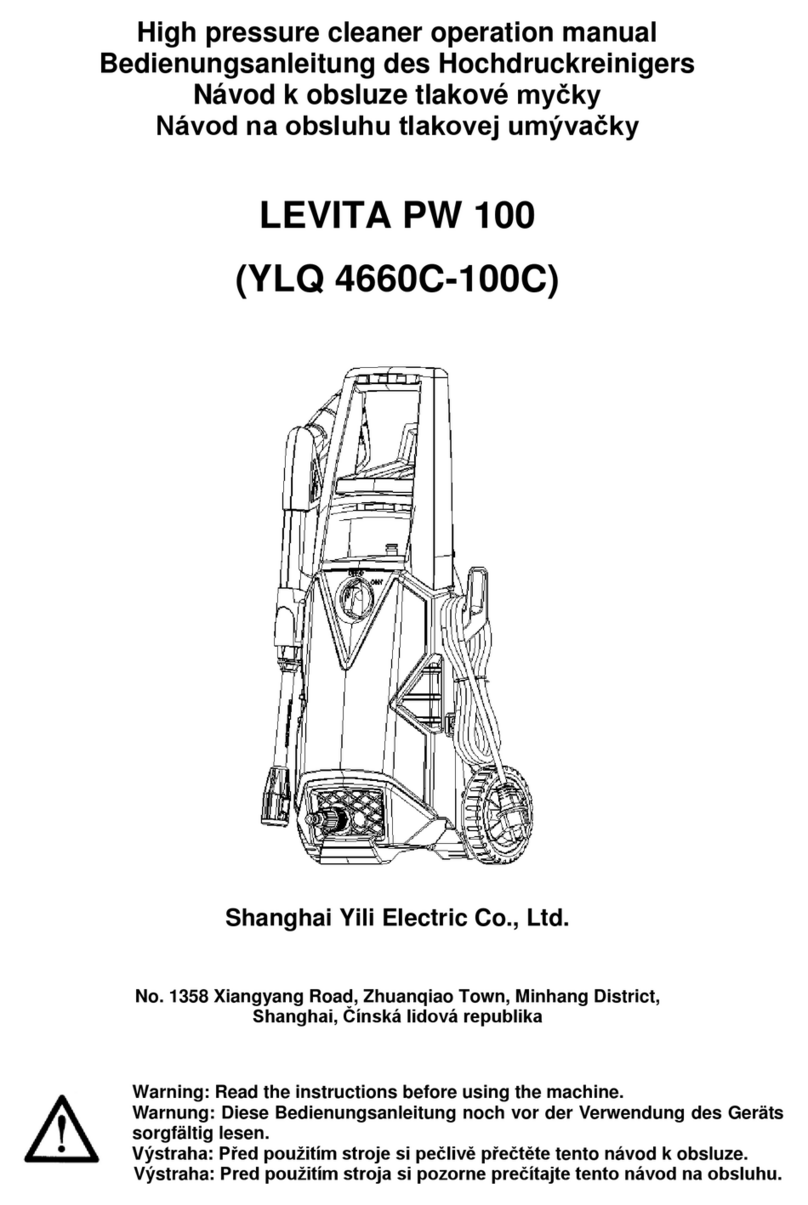
Mountfield
Mountfield Levita PW 100 Operation manual

Lavorwash
Lavorwash DAKOTA-R XP Translation of the original instructions

Kärcher
Kärcher K 5 Basic Original instructions
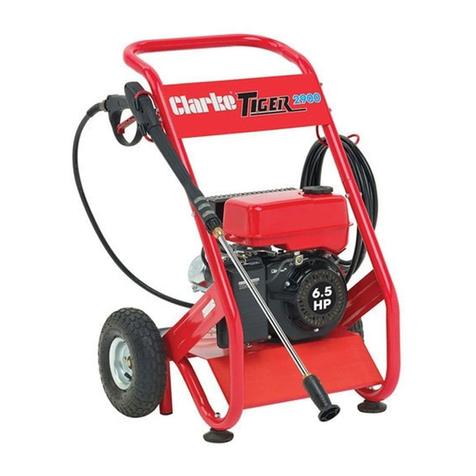
Clarke
Clarke TIGER 2500 Operation & maintenance instructions
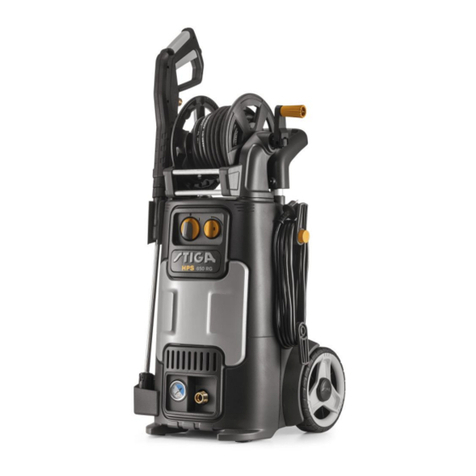
Stiga
Stiga HPS 110 troubleshooting manual
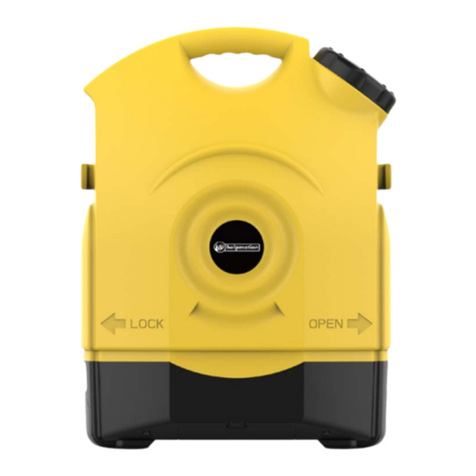
Helpmation
Helpmation JP-C1H manual
